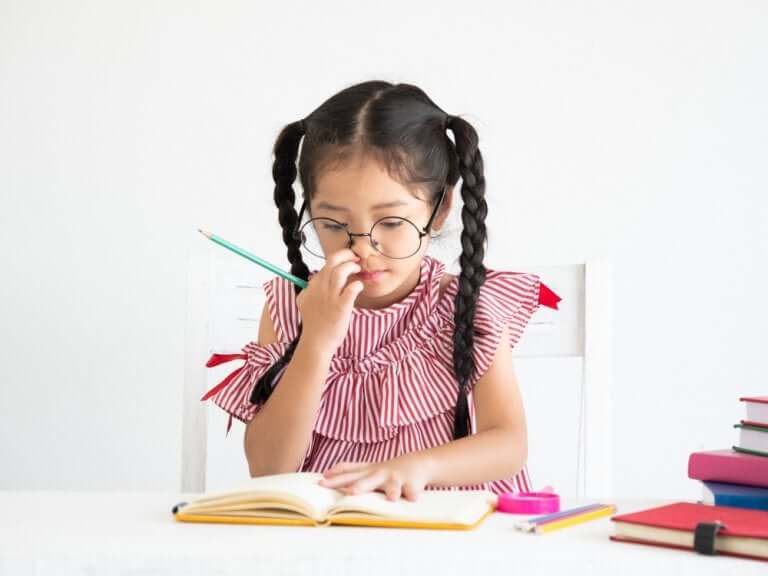Teaching Children to Create Diagrams for Studying

There are several study techniques that children have to learn to use in order to get good academic results. In this article, we’re going to explain how to use diagrams for studying.
Making diagrams or outlines is a good way of summarizing information in order to remember concepts and facts better. It’s a good idea to teach this study technique to children from an early age, so they can learn to study effectively and efficiently.
We must bear in mind that diagrams are only one step of many that should be carried out in the complex world of studying. There are, in all, five phases of study that we can differentiate:
- Reading comprehension
- Underlining
- Summaries
- Memorizing
- Self-assessment
The habit of studying should be carried out under environmental, spatial, temporary, yet similar conditions. The habit of studying is the first step for students to be able to activate and develop the ability to learn
–García Huidobro–
Teach children to make diagrams for studying
When you need to summarize information, you need to be able to use different strategies to organize or compile that information. It needs to be done in such a way that will allow you to modify the content to make it easier to assimilate and memorize. This is where diagrams or outlines become very useful.

Diagrams visually and clearly represent the main and secondary ideas of any given text. The great advantage they have, compared to other summarizing techniques, is that they allow you to capture relevant information at a glance.
There are different types of diagrams, depending on the type of study material:
- Comparatives: These are used to compare characteristics and observe information at a glance.
- Hierarchical: You can use this type of diagram to organize and classify the ideas of a text, and integrate some of the concepts into other texts.
- Sequenced: These can be used when you need to order the information sequentially, based on different factors (the passage of time, method changes, changes in characteristics, etc.).
It’s important to transmit the idea of diagrams to our children. However, in order to learn this study technique, it isn’t enough to just know the theory. It also requires a lot of practice.
For this reason, it’s a good idea for the parents to accompany their children during the study sessions. They’ll be able to help them create their first visual diagrams, so that, with time, they’ll be able to do them on their own.
“Never consider study as an obligation, but as an opportunity to go deeper into the beautiful and wonderful world of knowledge”
–Albert Einstein–
Characteristics of a good diagram
To create a good diagram, you must follow several steps:
- Firstly, read the text carefully
- Then, select and underline the main and secondary ideas
- Think of a title that sums up the text
- After that, choose the type of diagram that you want to do
- Divide the text into general sections and subsections
- Finally, put each idea into a different section and express it briefly and accurately

Diagrams or outlines for studying should also fulfill the following characteristics:
- You should integrate all the main ideas into the diagram
- You should highlight and clearly link the main ideas of the text
- It has to follow a logical structure, with the main and secondary ideas well arranged
- The presentation must be clear so that the content can be understood quickly
- It must be written using short or direct keywords or phrases, never long sentences.
By following these tips, children will learn to develop meaningful diagrams which will help them to improve their performance at school. They’ll be able to see, at a glance, a general idea of the topics and how they fit together.
All of this is beneficial for them to be able to acquire, assimilate, understand, and remember information with ease. This requires work, time, and effort, but it’s certainly worth it!
“If you want to succeed, don’t stare at the stairs. Start climbing, step by step, until you reach the top.”
–Anonymous–
There are several study techniques that children have to learn to use in order to get good academic results. In this article, we’re going to explain how to use diagrams for studying.
Making diagrams or outlines is a good way of summarizing information in order to remember concepts and facts better. It’s a good idea to teach this study technique to children from an early age, so they can learn to study effectively and efficiently.
We must bear in mind that diagrams are only one step of many that should be carried out in the complex world of studying. There are, in all, five phases of study that we can differentiate:
- Reading comprehension
- Underlining
- Summaries
- Memorizing
- Self-assessment
The habit of studying should be carried out under environmental, spatial, temporary, yet similar conditions. The habit of studying is the first step for students to be able to activate and develop the ability to learn
–García Huidobro–
Teach children to make diagrams for studying
When you need to summarize information, you need to be able to use different strategies to organize or compile that information. It needs to be done in such a way that will allow you to modify the content to make it easier to assimilate and memorize. This is where diagrams or outlines become very useful.

Diagrams visually and clearly represent the main and secondary ideas of any given text. The great advantage they have, compared to other summarizing techniques, is that they allow you to capture relevant information at a glance.
There are different types of diagrams, depending on the type of study material:
- Comparatives: These are used to compare characteristics and observe information at a glance.
- Hierarchical: You can use this type of diagram to organize and classify the ideas of a text, and integrate some of the concepts into other texts.
- Sequenced: These can be used when you need to order the information sequentially, based on different factors (the passage of time, method changes, changes in characteristics, etc.).
It’s important to transmit the idea of diagrams to our children. However, in order to learn this study technique, it isn’t enough to just know the theory. It also requires a lot of practice.
For this reason, it’s a good idea for the parents to accompany their children during the study sessions. They’ll be able to help them create their first visual diagrams, so that, with time, they’ll be able to do them on their own.
“Never consider study as an obligation, but as an opportunity to go deeper into the beautiful and wonderful world of knowledge”
–Albert Einstein–
Characteristics of a good diagram
To create a good diagram, you must follow several steps:
- Firstly, read the text carefully
- Then, select and underline the main and secondary ideas
- Think of a title that sums up the text
- After that, choose the type of diagram that you want to do
- Divide the text into general sections and subsections
- Finally, put each idea into a different section and express it briefly and accurately

Diagrams or outlines for studying should also fulfill the following characteristics:
- You should integrate all the main ideas into the diagram
- You should highlight and clearly link the main ideas of the text
- It has to follow a logical structure, with the main and secondary ideas well arranged
- The presentation must be clear so that the content can be understood quickly
- It must be written using short or direct keywords or phrases, never long sentences.
By following these tips, children will learn to develop meaningful diagrams which will help them to improve their performance at school. They’ll be able to see, at a glance, a general idea of the topics and how they fit together.
All of this is beneficial for them to be able to acquire, assimilate, understand, and remember information with ease. This requires work, time, and effort, but it’s certainly worth it!
“If you want to succeed, don’t stare at the stairs. Start climbing, step by step, until you reach the top.”
–Anonymous–
All cited sources were thoroughly reviewed by our team to ensure their quality, reliability, currency, and validity. The bibliography of this article was considered reliable and of academic or scientific accuracy.
- Molina, F. (2017). Taller técnicas de estudio. Proyecto Creciendo. Recuperado de: http://ampaiesalpedrete.org/wp-content/uploads/2017/09/Proyecto-Taller-Tecnicas-Estudio.pdf
- Serrate, R. (2008). Ayúdale a estudiar. Las claves del éxito escolar. España: Ediciones del Laberinto.
This text is provided for informational purposes only and does not replace consultation with a professional. If in doubt, consult your specialist.








